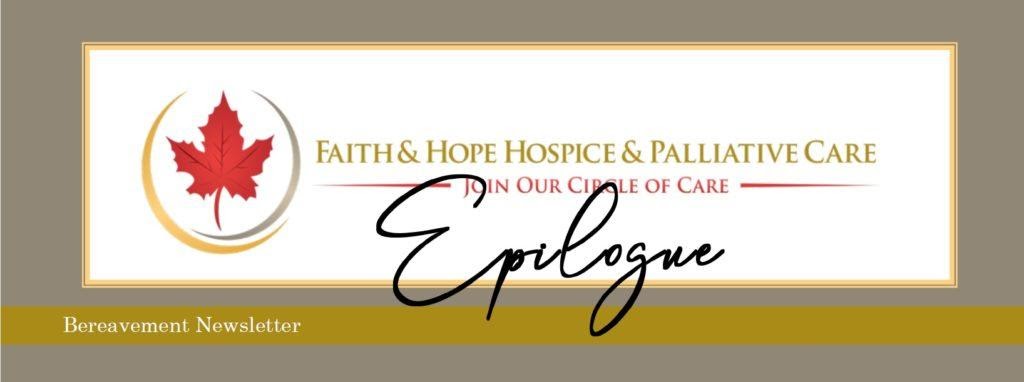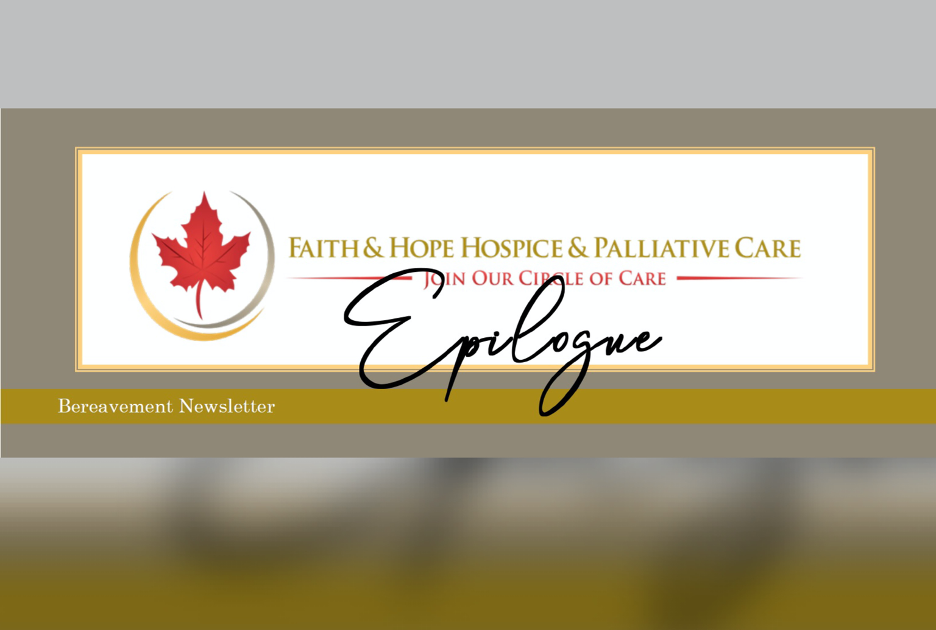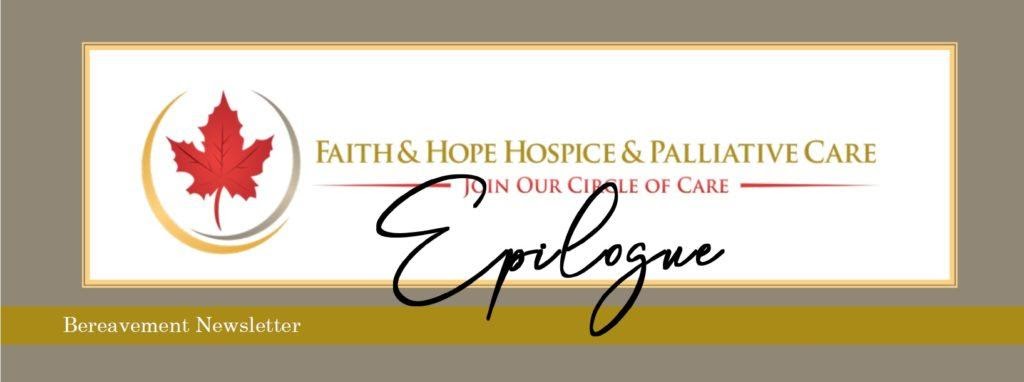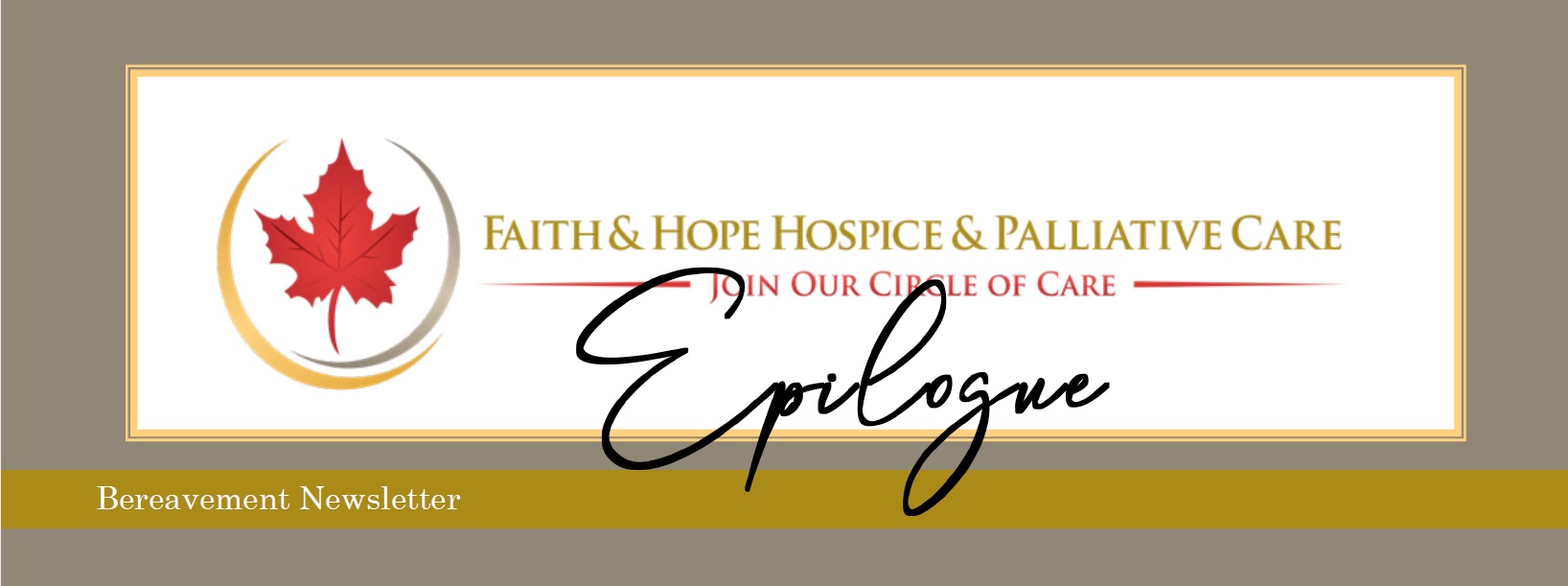Epilogue Bereavement Newsletter Archives – Faith and Hope Hospice
- By: administrator
- Epilogue Bereavement Newsletter
- No Comments
Welcome! Epilogue March-April 2021
Epilogue is the official bereavement newsletter of Faith & Hope Hospice in Pasadena CA In this issue we explore: • Laughter & Grief• Book Recommendation: Nothing Was the Same by Kay Redfield Jamison • Movie Review: Things We Lost in the Fire• Grief Explored: Tasks of Mourning• Grief & (No) Sleep: Part I • Recipe for Totsong Bangus (Milkfish)• Grief
- By: administrator
- Epilogue Bereavement Newsletter
- No Comments
Welcome! Epilogue January-February 2021
Epilogue is the official bereavement newsletter of Faith & Hope Hospice in Pasadena CA In this issue we explore: • Children’s Grief • Book Review: Surviving the Death of a Sibling by T.J. Wray • Movie Review: P.S. I Love You • Grief Explored: Growing Around Grief • Mindfulness and Guided Imagery • Recipe for Grandma’s Chicken and Rice • Self-Care Click here to download the
- By: administrator
- Blog, Epilogue Bereavement Newsletter
- No Comments
Welcome! Epilogue November/December 2020
The Epilogue is the official bereavement newsletter of Faith & Hope Hospice in Pasadena CA In this issue we explore: • Grief and the Holidays• Book Review: The Five Invitations by Frank Ostaseski• Movie Review: The Family Stone• Grief Explored: Intuitive and Instrumental Grief• Light the Night: Annual Patient Memorial• Stress and Grief• Grief-tivity: Salt-Dough Ornaments• Recipe for French Market
- By: administrator
- Blog, Epilogue Bereavement Newsletter
- No Comments
Welcome! Epilogue Sept/Oct 2020
Epilogue Sept Oct 2020 Epilogue is the official bereavement newsletter of Faith & Hope Hospice in Pasadena CA In this issue we explore: Grief vs. Depression Book Review: Grief is a Journey: Finding Your Path Through Loss by Kenneth J. Doka, PhD Movie Review: Coco Grief Explored: Grief Work Light the Night: Annual Patient Memorial Invitation New Volunteer Opportunities
- By: administrator
- Blog, COVID, Epilogue Bereavement Newsletter
- No Comments
Welcome! Epilogue July/ August 2020 Edition
Epilogue is the official bereavement newsletter of Faith & Hope Hospice, the best hospice Pasadena has to offer. In this issue we explore: Wrong ways to grieve? Secondary Loss COVID Conversations Online Support Group Survey Latino Experience of Grief During COVID-19 by Jessica Villafranco, BSW How to make a Memory Mobile Book Review: Men We Reaped: A Memoir by
- By: administrator
- Blog, COVID, Epilogue Bereavement Newsletter
- No Comments
Welcome! Epilogue May/June 2020 Edition
Epilogue is the official bereavement newsletter of Faith & Hope Hospice, the best hospice Los Angeles County has to offer. Serving Los Angeles, Pasadena, and the surrounding communities. This edition focuses on veterans and the COVID19 outbreak. We explore these topics: Needs of Grieving Veterans Grieving During a Pandemic Complicated Grief COVID-19 and Grief Supporting Children Through
- By: administrator
- Blog, Epilogue Bereavement Newsletter
- No Comments
Welcome! Epilogue March/April 2020 edition
Epilogue is the official bereavement newsletter of Faith & Hope Hospice, the best hospice Los Angeles County has to offer. Serving Los Angeles, Pasadena, and the surrounding communities. In this issue we explore: Managing the Transition from Caregiver to Mourner Ambiguous Loss and resources to learn more about this type of grief experience Glossary of Grief Terms
- By: administrator
- Blog, Epilogue Bereavement Newsletter
- No Comments
“Epilogue” January/February 2020
Epilogue is the official bereavement newsletter of Faith and Hope Hospice, the best hospice Los Angeles County has to offer. Serving Los Angeles, Pasadena, and the surrounding communities. Welcome to Epilogue’s first edition of 2020! This issue of the bereavement newsletter explores: the use of Aromatherapy as a way to cope with grief. Common Experiences
- By: administrator
- Blog, Epilogue Bereavement Newsletter
- No Comments
Epilogue: Bereavement Newsletter, Nov/Dec 2019
Epilogue November/December 2019 Faith and Hope Hospice Pasadena is the best hospice Los Angeles County has to offer. Serving Los Angeles, Pasadena, and the surrounding communities. Click here to download the latest edition of Faith & Hope Hospice’s bereavement newsletter, Epilogue. This edition of Epilogue covers the following topics: – Grief & the Holidays– Children’s
- By: administrator
- Blog, Epilogue Bereavement Newsletter
- No Comments




